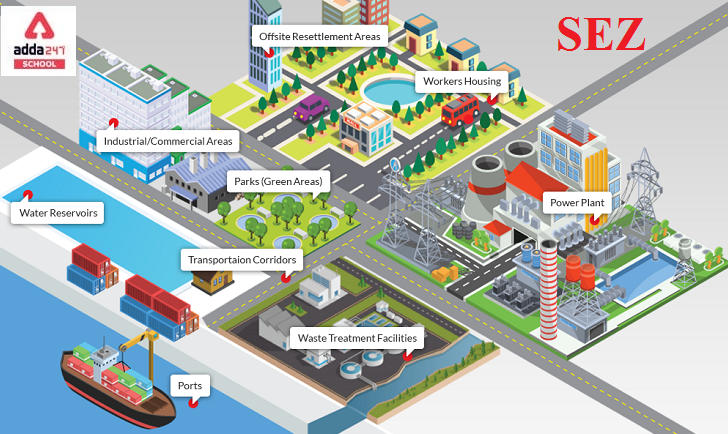IT SEZ Full Form
IT SEZs are areas that have different IT business and trade laws within that area or territory than what the rest of the country has to follow. Each government determines its own concept of an SEZ.
IT SEZ Full Form in India
The full form of the abbreviation IT SEZ is Information Technology Special Economic Zone. SEZs or Special Economic Zones are the areas where business and trade laws are differently applied.
SEZs are Special Economic Zones placed within a country’s borders with the goals of improving trade balance, employment, increased investment, job creation, and efficient administration. Financial policies are in place to encourage firms to establish themselves in the zone. Investing, taxing, commerce, quotas, customs, and labour restrictions are all examples of these policies. Companies may also be offered tax vacations, in which they are allowed a period of reduced taxation after establishing themselves in a zone.
Read About IPPB ( India Post Payment Bank )
IT SEZ Full Form in Hindi
एसईजेड का पूर्ण रूप विशेष आर्थिक क्षेत्र है। एसईजेड या विशेष आर्थिक क्षेत्र ऐसे क्षेत्र हैं जहां व्यापार और व्यापार कानून अलग–अलग लागू होते हैं।
एसईजेड विशेष आर्थिक क्षेत्र हैं जो व्यापार संतुलन, रोजगार, बढ़े हुए निवेश, रोजगार सृजन और कुशल प्रशासन में सुधार के लक्ष्यों के साथ देश की सीमाओं के भीतर स्थित हैं। फर्मों को क्षेत्र में खुद को स्थापित करने के लिए प्रोत्साहित करने के लिए वित्तीय नीतियां मौजूद हैं। निवेश, कर, वाणिज्य, कोटा, सीमा शुल्क और श्रम प्रतिबंध इन नीतियों के सभी उदाहरण हैं। कंपनियों को भी कर अवकाश की पेशकश की जा सकती है, जिसमें उन्हें एक क्षेत्र में खुद को स्थापित करने के बाद कम कराधान की अवधि की अनुमति दी जाती है।
Read About Food Chain
IT SEZ Full Form in India: A look at the history
The first Export Processing Zone (EPZ) in India was established in Kandla in 1965, becoming the Indian Special Economic Zone. Because the economic reforms implemented in the early 1990s did not result in the overall growth of the Indian economy, the Special Economic Zone was established. Economic reforms implemented in the 1990s did not yield the expected benefits. During the second half of the 1990s, the Indian manufacturing sector experienced a sharp slowdown in overall growth.
As per what was observed in the history of SEZs in India, red tape, complex administrative procedures, rigid labour regulations, and insufficient physical infrastructural facilities were the primary causes of the decline in FDI influx to India. Furthermore, the Indian financial markets were not yet sophisticated enough to allow for the simple admission of foreign institutional investors into the Indian economy. Furthermore, the Indian economy’s legislative framework was insufficient to prevent foreign investors from abusing Indian markets. Despite the central government’s liberal economic policies, the lack of an investor-friendly climate in India hampered the expansion of Indian industry.
As a result, a considerably larger and more efficient version of its ancestors was formed, complete with world-class infrastructure.
In April of 2000, the Special Economic Zone (SEZ) Policy was released. As a result, a considerably larger and more efficient version of its ancestors was formed, complete with world-class infrastructure. On the 10th of February 2006, the SEZ Act of 2005 and the SEZ Rules took effect.
Meaning of SEZs in India: Set up of the Administration
A three-tier administrative structure governs the operation of the SEZs. The apex body is the Board of Approval, which is led by the Secretary of Commerce. The Zone Approval Committee oversees the approval of units in the SEZs as well as other associated problems. Each Zone is led by a Development Commissioner, who also serves as the Approval Committee’s ex-officio chairperson.
Units may be established in an SEZ once it has been approved by the Board of Approval and the area of the SEZ has been announced by the Central Government. The Approval Committee, which consists of the Development Commissioner, Customs Authorities, and State Government members, approves all proposals for the establishment of units in the SEZ at the Zone level. The Development Commissioner grants all post-approval permissions, such as an importer-exporter code number, a change in the company or implementing agency’s name, broad banding diversification, and so on, at the Zone level. The Approval Committee monitors the performance of the SEZ units on a regular basis, and units that violate the approval requirements are subject to penalties under the Foreign Trade (Development and Regulation) Act.









 HPBOSE Compartment Date Sheet 2025 Out, ...
HPBOSE Compartment Date Sheet 2025 Out, ...
 RUHS Counselling 2025 Round 1 Seat Allot...
RUHS Counselling 2025 Round 1 Seat Allot...
 Bihar Board Dummy Registration Card 2026...
Bihar Board Dummy Registration Card 2026...










